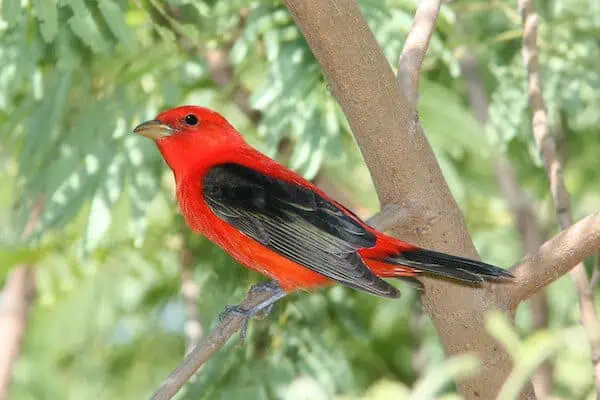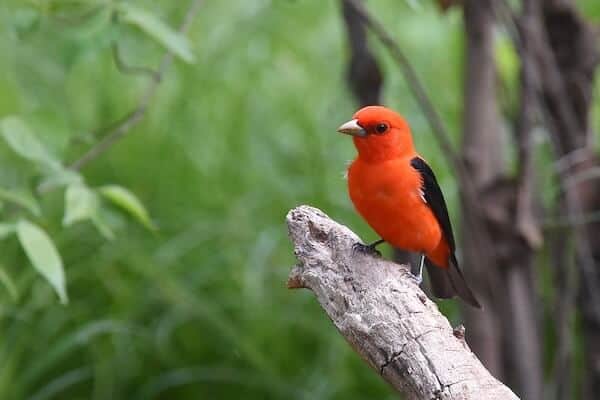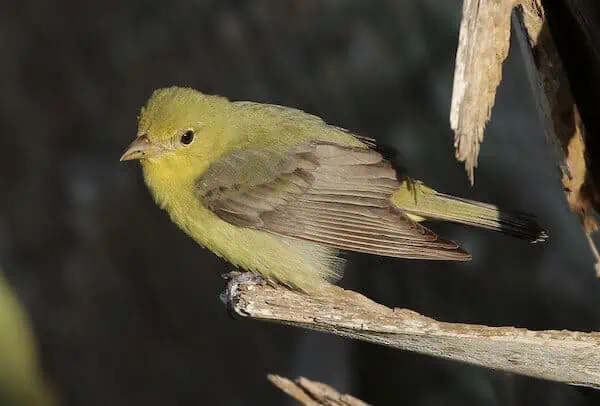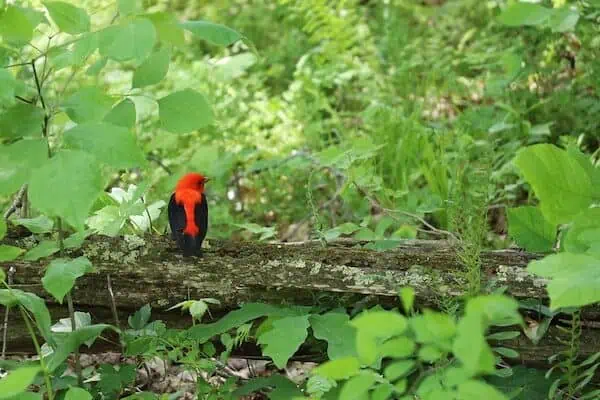Scarlet tanagers are one of the most strikingly beautiful birds in North America, with their colorful plumage and unique feeding behavior. These migratory birds are known for their distinctive song and fascinating behavior, making them a popular subject for bird watchers and nature enthusiasts alike. In this article, we will explore some interesting facts about scarlet tanagers, from their breeding habits to their foraging behavior, and discover what makes these birds so unique. So, let’s dive in and learn more about these beautiful birds!
8 Facts About Scarlet Tanagers
1. They Change Colors Throughout the Year
Even though scarlet tanagers are known for having bright and bold feathers, male birds actually change their colors between seasons. During the breeding season (spring to summer), males are a deep shade of scarlet red with a black wing. Once breeding is over, males start to molt, causing a dramatic change in their appearance.
Outside of the breeding season, male scarlet tanagers actually have yellow-green feathers, which makes them look fairly similar to females of their species. In the spring, before breeding season begins, males will molt again, revealing the rich red feathers that they’re known for.

2. They’re Monogamous
Although the scarlet tanager doesn’t mate for life, these birds are serial monogamists. It’s typical for a breeding pair to stay together for an entire season. Some pairs may continue to travel and live together across multiple seasons.
Once a pair has mated, the male will defend their territory from potential threats, while females will build a nest for their young. After the chicks have hatched, both the mother and father work hard to keep the baby birds fed. Young birds usually stay with their parents for around two weeks, but some may remain with them for a few weeks longer.
3. Scarlet Tanagers Have a Distinctive Song
As songbirds, scarlet tanagers tend to be very vocal. While their song is frequently compared to that of a robin’s, scarlet tanagers have a warble that’s slightly deeper and more hoarse. Their call has been described as a “chick-burr,” while others say it sounds more like “tisk-a-leee.”
Females have slightly softer voices than males do, but they still love to sing. Mated pairs will even sing together! Scarlet tanagers are most vocal during breeding season, and males will even use their songs as a way to mark their territory or attract potential mates.

4. They Don’t Typically Visit Bird Feeders
A bird feeder can attract many types of birds, but it’s unlikely to bring a scarlet tanager to your yard. This bird’s main food source is insects, and it’s happy to hunt for ants, flies, bees, and other creatures. While it does supplement its diet with other types of foods, it usually searches for berries and tender buds, not seeds.
If you want to entice scarlet tanagers, try planting berry bushes in your yard. Some of their favorite berries include blackberries and mulberries. You can also leave out orange slices, like you might when trying to attract orioles. In the summer, these birds are also attracted to water features, like fountains and bird baths.
5. Scarlet Tanagers Have a Long Commute
Like many bird species, scarlet tanagers fly south through the winter so that they have a steady supply of food to eat. While some birds fly short distances, these birds travel all the way from North America to South America. These long-distance migrants will fly as far as 4,000 miles when the seasons start to change.
While scarlet tanagers can be spotted in several South American countries during the winter, they’re commonly spotted in the Andes mountain region. They do most of their flying at night and stop to rest during the day. Whether they’re flying north or south, these birds like to travel in large groups.

6. Scarlet Tanagers Are Speedy Eaters
If a scarlet tanager is hungry, it won’t waste any time before chowing down on its food source. In fact, one scarlet tanager was spotted eating a whopping 600 tent caterpillars in only 15 minutes. If birds don’t have young to feed, they’ll usually forage independently, and they’ll keep eating until they’re full.
Not only do scarlet tanagers eat quickly, but they look for food in a variety of places. They’re known to forage for food on the ground and in the tops of trees. They’ll even snatch some insects, like flies, straight out of the air!

7. They Have Many Natural Predators
There are many animals that pose a threat to scarlet tanagers. Many birds of prey, including owls and merlins, are known to feed on these songbirds.
Not only do scarlet tanagers need to watch out for attacks from other birds, but many creatures attack their nests. Snakes and squirrels will both attack nests if they’re left unattended. Other birds, like crows and blue jays, are a threat to nests as well.
8. Other Birds Will Infest Their Nests
Brown-headed cowbirds are a stocky type of blackbird that acts as a brood parasite towards the scarlet tanager. These birds lay their eggs in the nest of scarlet tanagers and leave them behind for the other birds to hatch and raise.
Cowbird eggs grow faster than the eggs of scarlet tanagers, and they also tend to be much larger. Once baby cowbirds have hatched, they may even push tanager eggs out of the nest in order to ensure their survival. To protect themselves against these nest parasites, scarlet tanagers try to build nests in larger forests near the tops of trees.

9. They Can Eat Deadly Insects
Scarlets tanagers eat a variety of insects, but some of the creatures they feed on can potentially be dangerous. Not only do these birds have thick, round beaks that are effective at catching insects, but they have ways of disarming their prey.
If a scarlet tanager catches an insect with a stinger, like a wasp or hornet, in its beak, it will scrape the insect against tree bark or a branch before it eats it. This disarms the insect, allowing the bird to eat it safely. Thanks to this approach, scarlet tanagers can munch on any small insects they come across!





